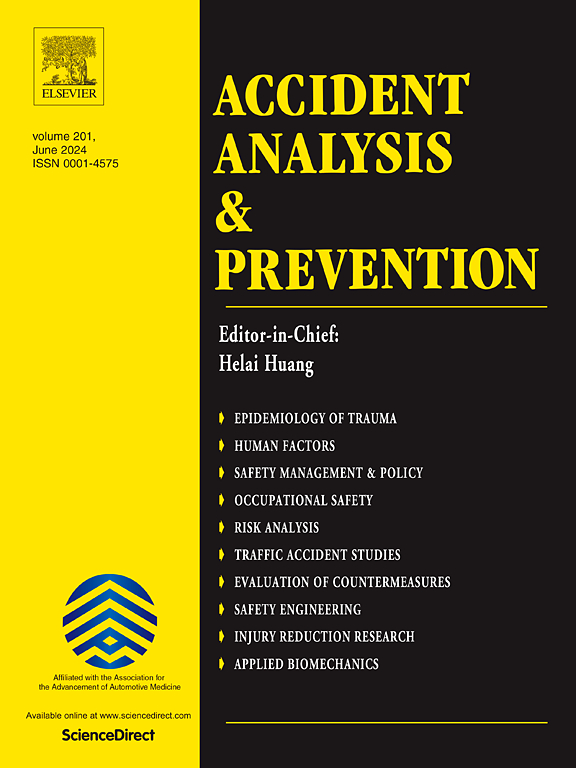反光环能否增强驾驶员对高速公路隧道空间路权的安全感知?模拟探索。
IF 5.7
1区 工程技术
Q1 ERGONOMICS
引用次数: 0
摘要
为了研究反光环能否增强驾驶员对高速公路隧道空间路权的感知,本文进行了模拟测试。本文阐明了隧道中空间路权的特征,并使用常用的划线器和路面凸起标线与逆反射环进行了对比测试,以增强空间路权感知。测试采用横向偏差和纵向距离感知作为反映横向和纵向路权的指标。根据高速公路隧道的设计标准,使用 3Ds Max 软件创建了包含不同设施和间距的视频场景。选择主观等距刺激(SSED)、横向偏差和感知反应时间(PRT)指标来评估不同设施在不同间距条件下对驾驶员的影响。52 名参与者分为新手驾驶员和老手驾驶员两组,在模拟驾驶环境中进行了感知测试。结果表明,在没有设施的情况下,驾驶员对纵向距离的高估程度最高,对横向偏差的PRT最长。安装间距为 50-200 米的反光环可显著减少对纵向距离的高估,同时降低横向偏离的 PRT。另一方面,设置间距为 6-12 米的划线器和凸起路面标线可显著降低横向偏离的 PRT,而对纵向距离的感知却没有明显改善。建议在直行路段中,反光环的间距为 200 米,划线器和路面凸起标线的间距为 10 米,这是一种更安全、更经济的设置方案。这些设施的组合可以增强驾驶员对高速公路隧道空间路权的安全感知,有利于快速感知、正确判断和及时决策,保证车辆安全通过。本文章由计算机程序翻译,如有差异,请以英文原文为准。
Can retroreflective rings enhance drivers’ safety perception of spatial right-of-way in freeway tunnels? A simulation exploration
In order to investigate whether retroreflective rings can enhance drivers’ perception of spatial right-of-way in freeway tunnels, this paper explores a simulation test. The characteristics of spatial right-of-way in tunnels are elucidated, and a comparative test is conducted using commonly used delineators and raised pavement markers against retroreflective rings to enhance the perception of spatial right-of-way. The test employs the perception of lateral deviation and longitudinal distance as indicators to reflect the lateral and longitudinal right-of-way. Video scenarios, incorporating different facilities and spacing, are created using 3Ds Max software following the design standards of freeway tunnels. The indicators of Stimulation of Subjectively Equal Distance (SSED), lateral deviation, and perception reaction time (PRT) are chosen to assess the effects of different facilities on drivers under varying spacing conditions. Fifty-two participants, divided into two groups of novice drivers and experienced drivers, underwent perception testing in a simulated driving environment. The results indicate that drivers exhibit the highest overestimation of longitudinal distance and the longest PRT of lateral deviation in the absence of facilities. Installing retroreflective rings with a spacing of 50–200 m significantly mitigates the overestimation of longitudinal distance, while reducing the PRT of lateral deviation. On the other hand, setting up delineators and raised pavement markers with a spacing of 6–12 m significantly reduces the PRT of lateral deviation, while there is no significant enhancement to the perception of longitudinal distance. A spacing of 200 m for retroreflective rings and 10 m for delineators and raised pavement markers in the straight section is recommended as a safer and more economical setting scheme. The combination of these facilities can enhance drivers’ safety perception of spatial right-of-way in freeway tunnels, facilitating rapid perception, correct judgment, and timely decision-making for the safe passage of vehicles.
求助全文
通过发布文献求助,成功后即可免费获取论文全文。
去求助
来源期刊

Accident; analysis and prevention
Multiple-
CiteScore
11.90
自引率
16.90%
发文量
264
审稿时长
48 days
期刊介绍:
Accident Analysis & Prevention provides wide coverage of the general areas relating to accidental injury and damage, including the pre-injury and immediate post-injury phases. Published papers deal with medical, legal, economic, educational, behavioral, theoretical or empirical aspects of transportation accidents, as well as with accidents at other sites. Selected topics within the scope of the Journal may include: studies of human, environmental and vehicular factors influencing the occurrence, type and severity of accidents and injury; the design, implementation and evaluation of countermeasures; biomechanics of impact and human tolerance limits to injury; modelling and statistical analysis of accident data; policy, planning and decision-making in safety.
 求助内容:
求助内容: 应助结果提醒方式:
应助结果提醒方式:


